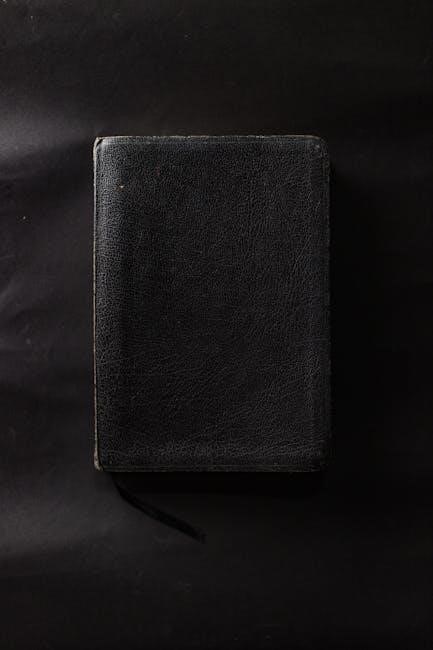
Biblical typology explores how people‚ events‚ and objects in the Old Testament foreshadow Christ and salvation․ It reveals God’s plan through types and shadows‚ enriching our understanding of Scripture․

Definition of Typology in the Bible
tupos (τύπος)‚ meaning “example” or “pattern‚” underpins this concept․ Types are not mere illustrations but divinely ordained representations that point to greater spiritual realities․ For instance‚ Adam is seen as a type of Christ‚ and the Passover symbolizes Christ’s sacrifice․ These typologies are identified in the New Testament‚ confirming their theological significance․ They reveal God’s consistent plan of redemption‚ showcasing how the Old Testament foreshadows the New․ Typology enriches biblical interpretation‚ highlighting the unity of Scripture and the fulfillment of God’s promises in Christ․ It serves as a powerful tool for understanding salvation history and the profound connections between the testaments․
The Purpose of Typology in Understanding Salvation History

The purpose of typology is to illuminate God’s overarching plan of salvation by connecting Old Testament events‚ people‚ and objects to their fulfillment in Christ․ It reveals how the entire Bible coheres‚ showing that every part contributes to the narrative of redemption․ Typology demonstrates that the Old Testament is not isolated but anticipates the Messiah and His work․ For example‚ the Passover prefigures Christ’s sacrifice‚ and Jonah’s resurrection after three days symbolizes Christ’s victory over death․ This theological framework helps believers grasp the unity of Scripture‚ seeing Jesus as the ultimate fulfillment of all types and shadows․ By studying typology‚ Christians deepen their understanding of God’s sovereignty and the progression of His redemptive plan throughout history․ It bridges the testaments‚ offering a richer appreciation of the Bible’s message and the centrality of Christ in all of God’s dealings with humanity․ Through typology‚ the gospel becomes the climax of a divinely orchestrated story․

Key Concepts in Biblical Typology

Typology involves types‚ shadows‚ and figures in the Old Testament that foreshadow Christ and salvation․ These elements reveal God’s plan‚ enriching our understanding of the Bible’s unity and Christ’s role․
Types‚ Shadows‚ and Figures in the Old Testament
Types‚ shadows‚ and figures in the Old Testament are representations that foreshadow Christ and salvation․ Adam‚ as a type of Christ‚ illustrates the contrast between sin and redemption․ Isaac‚ offered as a sacrifice‚ prefigures Jesus’ ultimate sacrifice․ Jonah’s three days in the fish symbolize Christ’s resurrection․ The Passover‚ with its blood covering‚ points to Christ’s atoning death․ These typologies reveal God’s plan‚ showing how Old Testament events and figures anticipate New Testament realities․ They emphasize the unity of Scripture and the central role of Christ in salvation history․ By studying these types‚ believers gain deeper insights into God’s redemptive plan and the fulfillment of prophecy in Jesus Christ․
The Relationship Between the Old and New Testaments
The Old and New Testaments are deeply interconnected through typology‚ where the former foreshadows the latter․ The Old Testament sets the stage for the fulfillment of God’s plan in Christ․ Events‚ people‚ and objects in the Old Testament act as types or shadows that point to Jesus and the salvation He brings․ For example‚ Adam’s role as the first man contrasts with Christ‚ the “second Adam‚” who brings redemption․ The Passover in Exodus prefigures Christ’s sacrifice‚ while Jonah’s resurrection after three days mirrors Christ’s victory over death․ This relationship highlights God’s unified plan of salvation‚ showing how the Old Testament prepares humanity for the New Testament’s revelation of Jesus․ Typology underscores the continuity and fulfillment of God’s promises‚ revealing the Bible as a cohesive narrative centered on Christ․
Typology as a Tool for Exegesis and Hermeneutics
Typology serves as a powerful tool in biblical exegesis and hermeneutics‚ aiding scholars in uncovering deeper spiritual truths․ By identifying Old Testament types‚ such as Adam and Isaac‚ and their New Testament fulfillment in Christ‚ typology bridges historical contexts․ This method ensures that interpretation aligns with Scripture’s unity‚ preventing isolated or disjointed readings․ Typology also enhances the understanding of symbolic elements like the Bronze Serpent and the Tabernacle‚ revealing their connection to Christ’s work․ Properly applied‚ typology enriches preaching‚ teaching‚ and personal study‚ offering insights into God’s redemptive plan․ It emphasizes the Bible’s coherence and underscores Christ as the ultimate fulfillment of all biblical themes․ Thus‚ typology is indispensable for interpreting Scripture faithfully and comprehensively․


Major Typologies in the Bible
Key biblical typologies include Adam‚ Isaac‚ Jonah‚ and the Passover‚ each prefiguring Christ’s redemption․ These examples highlight God’s consistent plan of salvation through symbolic persons and events․
Adam as a Type of Christ
Adam is a significant type of Christ‚ as both are central to God’s plan of salvation․ Adam‚ the first man‚ represents humanity’s fallen nature through his disobedience in the Garden of Eden․ Similarly‚ Christ‚ the “Second Adam‚” redeems humanity through His obedience and sacrifice on the cross․ This typology is explicitly stated in Romans 5:14‚ where Adam is described as a “type” of Christ․ Both figures are linked through their roles as representatives of humanity—Adam leading to condemnation and Christ leading to justification․ This parallel underscores the theological connection between the Old and New Testaments‚ demonstrating how Christ’s work fulfills and restores what was lost through Adam’s sin․ This typology emphasizes the redemptive arc of salvation history‚ highlighting Christ as the ultimate solution to humanity’s spiritual crisis․
Isaac as a Type of Jesus
Isaac‚ the son of Abraham‚ serves as a profound type of Jesus‚ illustrating God’s plan of salvation․ In Genesis 22‚ Abraham’s willingness to sacrifice Isaac on Mount Moriah prefigures God’s sacrifice of His only Son‚ Jesus․ Both Isaac and Jesus are described as “only begotten” sons‚ highlighting their unique roles as beloved and chosen vessels of divine purpose․ Isaac’s obedience in carrying the wood for his own sacrifice mirrors Jesus’ willingness to bear the cross․ Additionally‚ Isaac’s “resurrection” after being spared by God foreshadows Christ’s resurrection‚ symbolizing victory over death․ This typology emphasizes trust‚ obedience‚ and redemption‚ drawing a direct line between the Old Testament narrative and the ultimate sacrifice of Christ․ Through Isaac‚ the Bible reveals the depth of God’s love and the redemptive plan fulfilled in Jesus․
Jonah and the Resurrection of Christ
Jonah’s three-day sojourn in the belly of the great fish is a powerful typology of Christ’s resurrection․ Jesus Himself drew this parallel in Matthew 12:40‚ stating that just as Jonah was three days and nights in the fish‚ so too would He spend three days and nights in the heart of the earth․ This typology underscores the redemptive plan of God‚ as Jonah’s deliverance from the fish foreshadows Christ’s triumph over death․ Both events symbolize divine deliverance and new life‚ with Jonah emerging alive and Christ rising victorious from the grave․ This typology highlights the continuity of God’s salvation story‚ linking the Old Testament narrative to the ultimate redemption achieved through Christ’s resurrection․ It serves as a vivid reminder of God’s faithfulness and the triumph of life over death․
The Passover as a Type of Christ’s Sacrifice
The Passover‚ instituted by God in Exodus‚ is a profound typology of Christ’s sacrifice․ The lamb without blemish‚ chosen by the Israelites‚ prefigured Christ‚ the Lamb of God‚ who would take away the sin of the world․ The blood of the Passover lamb‚ applied to the doorposts‚ protected the Israelites from death‚ symbolizing how Christ’s blood saves believers from spiritual death․ The Passover meal itself‚ with its unleavened bread and bitter herbs‚ foreshadowed the Last Supper‚ where Jesus instituted the Eucharist․ In 1 Corinthians 5:7‚ Paul explicitly connects Christ to the Passover‚ calling Him “our Passover Lamb․” This typology underscores God’s redemptive plan‚ revealing how the Old Testament event finds its ultimate fulfillment in Christ’s sacrificial death and resurrection․ The Passover thus serves as a vivid reminder of God’s faithfulness and the atonement achieved through Christ․
Typological Symbols and Their Meanings
Typological symbols in Scripture‚ like the bronze serpent and bread from heaven‚ foreshadow Christ’s redemption․ These symbols reveal divine patterns‚ connecting Old Testament events to New Testament fulfillments․
The Bronze Serpent and Healing Through Christ
In Numbers 21‚ Moses lifted the bronze serpent to heal the Israelites bitten by snakes․ Jesus referenced this in John 3:14-15‚ comparing it to His crucifixion․ As the serpent brought physical healing‚ Christ’s sacrifice offers spiritual healing from sin․ This typology illustrates how Old Testament events prefigure Christ’s redemptive work․ The bronze serpent symbolizes judgment and salvation‚ foreshadowing Christ’s death on the cross․ This connection emphasizes God’s consistent plan of salvation‚ where symbols and events in the Old Testament point to Christ’s ultimate sacrifice․ The bronze serpent typology underscores the theme of divine mercy and the necessity of faith in God’s provision for healing and redemption․ It serves as a powerful example of biblical typology‚ linking historical events to spiritual truths fulfilled in Christ․
The Tabernacle as a Type of Heavenly Realities
The Tabernacle‚ described in Exodus‚ is a profound type of heavenly realities․ Its design and structure symbolize God’s presence and the path to redemption; The Tabernacle’s materials‚ such as gold and fine linen‚ represent the purity and glory of God․ The Holy of Holies‚ containing the Ark of the Covenant‚ signifies God’s throne room‚ while the veil represents the separation between God and humanity․ In the New Testament‚ Christ is revealed as the true Tabernacle‚ connecting heaven and earth․ The Tabernacle’s furnishings‚ like the altar and lampstand‚ prefigure Christ’s sacrifice and divine light․ The Veil’s tearing at Christ’s crucifixion symbolizes the removal of separation‚ granting access to God․ This typology illustrates how the Old Testament points to Christ‚ emphasizing His role as the ultimate sacrifice and mediator of God’s presence․
Bread from Heaven and the Eucharist
The manna given to the Israelites in the wilderness is a significant type of Christ‚ the Bread of Life․ In Exodus‚ manna symbolized God’s provision and sustenance‚ prefiguring Christ’s role as the ultimate source of spiritual nourishment․ Jesus explicitly connects Himself to this typology in John 6:35‚ declaring‚ “I am the Bread of Life․” The Eucharist‚ a central sacrament in Christianity‚ further fulfills this type‚ as Christ offers His body as spiritual bread for believers․ The manna’s daily provision mirrors the ongoing nourishment believers receive through communion․ This typology emphasizes Christ’s fulfillment of Old Testament promises and His role as the sustainer of His people․ The connection between the bread from heaven and the Eucharist underscores the unity of God’s plan across both testaments‚ revealing the depth of Christ’s sacrifice and presence in the lives of believers․
Typology in Specific Books of the Bible

Matthew highlights Jesus as the fulfillment of Old Testament stories‚ while Luke emphasizes Christ’s mission․ Hebrews connects Old Testament rituals to Christ’s sacrifice‚ revealing deep typological significance․

Typology in the Book of Matthew
Matthew’s Gospel is rich in typology‚ presenting Jesus as the fulfillment of Old Testament figures and events․ The book emphasizes how Jesus embodies the true meaning of these types‚ revealing God’s salvation plan․ For instance‚ Matthew highlights Jesus as the new Moses‚ delivering God’s people from spiritual slavery‚ and as the true bread from heaven‚ surpassing the manna given to Israel․ The virgin birth of Jesus (Isaiah 7:14) and the flight to Egypt (Hosea 11:1) are examples of how Matthew uses Old Testament typology to illustrate Jesus’ divine mission․ Additionally‚ the bronze serpent lifted by Moses (Numbers 21:9) prefigures Christ’s crucifixion‚ a connection Jesus Himself makes (John 3:14)․ Matthew’s literary design and thematic focus on fulfillment make it a cornerstone for understanding biblical typology․
Typology in the Book of Luke
Luke’s Gospel uniquely emphasizes Jesus as the Savior for all humanity‚ weaving typology throughout its narrative․ Luke often highlights Old Testament figures and events that prefigure Christ’s mission‚ such as the Virgin Mary and the Magnificat‚ which echo Hannah’s prayer (1 Samuel 2)․ The genealogy of Jesus in Luke traces back to Adam‚ symbolizing Jesus as the second Adam‚ redeeming humanity’s fallen state․ Luke’s account of the Passover (Luke 22) underscores its typological fulfillment in Christ’s sacrifice․ Additionally‚ Jesus’ parables and miracles‚ like the feeding of the 5‚000‚ reflect Old Testament themes of divine provision‚ such as the manna in the wilderness․ These typological elements in Luke illustrate God’s plan to bring salvation to all nations‚ fulfilling the promises of the Old Testament and emphasizing Jesus’ universal mission․ Luke’s typology bridges the Old and New Testaments‚ revealing Christ as the ultimate fulfillment of God’s redemptive plan․
Typology in the Book of Hebrews
The Book of Hebrews is rich in typology‚ emphasizing Jesus Christ as the ultimate fulfillment of Old Testament types and shadows․ Key typological themes include the tabernacle‚ priesthood‚ and sacrifices․ Jesus is portrayed as the true High Priest‚ surpassing the Levitical order‚ offering a once-for-all sacrifice (Hebrews 10:12-14)․ The tabernacle is a shadow of heavenly realities‚ with Christ entering the true Holy of Holies (Hebrews 8:1-5)․ The Old Testament rest (Sabbath) is a type of the eternal rest believers find in Christ (Hebrews 4:1-11)․ These typologies highlight Christ’s superiority and the fulfillment of God’s plan in Him‚ bridging the old and new covenants․ The author of Hebrews uses these typological connections to deepen understanding of Christ’s work and encourage perseverance in faith․ This book masterfully illustrates how Old Testament symbols point to the ultimate reality in Jesus Christ․

Modern Resources for Studying Biblical Typology
Explore PDF guides‚ online tools‚ and recommended books that provide detailed insights into biblical typology․ These resources offer charts‚ symbolic meanings‚ and comprehensive lists to deepen your understanding of typological connections in Scripture․
PDF Guides and Charts on Biblical Typology
PDF guides and charts on biblical typology are invaluable resources for studying how Old Testament figures and events foreshadow Christ․ These materials provide detailed lists and visual representations of types‚ shadows‚ and symbols‚ offering a structured approach to understanding salvation history․ Many guides include charts that highlight specific typologies‚ such as Isaac as a type of Jesus or the Passover as a precursor to Christ’s sacrifice․ They often feature biblical references‚ explanations of symbolic meanings‚ and historical context to deepen comprehension․ Websites like The Pixelated Reality offer downloadable PDFs that explore these connections‚ making them accessible for personal or group Bible studies․ These resources are particularly useful for visual learners and those seeking a comprehensive overview of typological themes in Scripture․ By utilizing these tools‚ students of the Bible can gain a richer understanding of how God’s plan of redemption unfolds through typology․
Online Tools and Study Materials
Online tools and study materials have become essential aids for exploring biblical typology․ Websites like The Pixelated Reality offer downloadable PDF guides‚ charts‚ and infographics that visually map out typological connections between Old Testament figures and New Testament fulfillments․ These resources often include detailed explanations of symbols‚ events‚ and their prophetic significance․ For instance‚ charts on Jonah and the resurrection or the Passover as a type of Christ’s sacrifice provide clear visual representations․ Many platforms also offer interactive Bible study tools that allow users to explore typological themes dynamically․ Additionally‚ online libraries and forums dedicated to biblical studies provide access to scholarly articles‚ video lectures‚ and discussion groups focused on typology․ These materials are particularly useful for both personal study and group discussions‚ offering a wealth of information to deepen one’s understanding of how Old Testament types prefigure New Testament realities․
Recommended Books on Typology
Several books are highly recommended for deepening one’s understanding of biblical typology․ “The Bible and Typology” by Patrick Fairbairn is a classic work that explores how Old Testament types prefigure New Testament realities․ Another essential read is “Typology and the Gospel of John”‚ which examines how the Fourth Gospel uses typological themes to reveal Christ․ “The Tabernacle: A Type of Jesus Christ” by Kevin Conner provides a detailed analysis of the tabernacle as a typological symbol of Christ’s ministry․ Additionally‚ “A Study of Biblical Typology” by John Walvoord offers a comprehensive overview of key typologies throughout Scripture․ These books‚ along with others‚ serve as invaluable resources for scholars and lay readers alike‚ offering insights into the rich tapestry of biblical typology and its significance in understanding God’s salvific plan․ They are widely available in print and digital formats‚ making them accessible for theological studies․